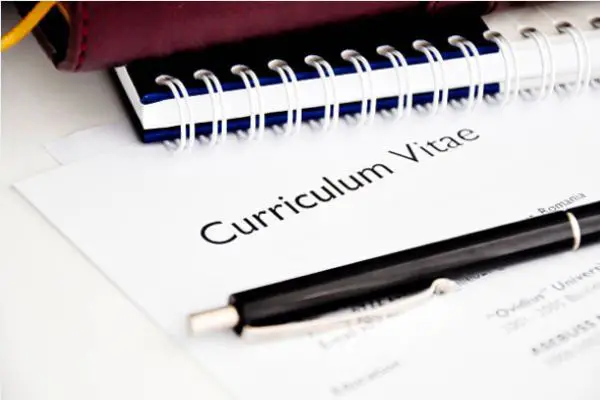By now, you have certainly realized how important it is to write a good resume (CV) when trying to find a new job.
A resume is realistically the only way you’ll show a hiring manager that you’re suitable for the position you’re applying for.
If you do not emphasize your abilities, qualities and skills, how will the job recruiter know that you are the right choice?
Luckily, creating the perfect resume for every job you’re not signed up for isn’t nearly as difficult as you’d imagine.

Below we provide you with important tips and tips on how to write a resume that will hopefully take you to the forefront of the order. If you need a guide, check out our CV template.
Determine which position you are applying for
Before you start the process of writing a resume, it is mandatory to double check whether you are applying for a suitable position.
In the digital age, most resumes are now sent online, meaning keyword optimization. In other words, your application must contain words relevant to the position you are looking for.
When you look for a job and look at the keywords a particular position is looking for and compare them to your skills, qualifications and achievements, it should quickly become clear to you if this is good.
Don’t try to add keywords that don’t fit your resume because it’s a waste of time and effort.
How to write a CV in 10 steps
1. The appearance of your resume
When writing your CV, make it in a Word document and ensure that you can fit everything into two pages; It’s no longer than this, because the recruit won’t even look at it.
Be sure to save it as a standard attachment to your name as a file name; this makes it easy to find and send e-mail. Let’s take a closer look at how your CV should look in the form of formats and layout.
2. Font
A safe bet is the Times New Roman font size 12. However, there are a plethora of easy-to-read fonts that can be used, including Garamond, Tahoma, and Century Gothic; Just stick to one font.
Make sure the titles and your name stand out as the title; this means that you can increase the font size to 14 or 16.
When it comes to important information, feel free to optimize, underline, or bold the appropriate sections and use the label point if necessary.
3. Contact information
- Name and address: self-clarification.
- Phone numbers: Turn on your mobile number and consider adding a personal voicemail in case you miss a call from recruiters. You can include a home phone number, but only if you live with people who can be trusted to politely respond and receive messages; This means that there are no tenants.
- E-mail address: Use a professional sound system; The best option is your first and last name or a variation of the same.
- Social media: You can include details about social media accounts, but ONLY if they are substantive. It should be noted that an increasing number of DO companies are reviewing the accounts of potential social media employees who are thought to have the opportunity to at least get an interview. If you have compromising photos or data, get rid of them before embarking on a job search. While it’s true that once something shows up online, it really never goes away, most companies won’t have a problem digging up dirt; at least not before the conversation phase!
Information you do NOT need to include:
- Marital status: immaterial.
- Citizenship: It doesn’t matter if you don’t apply outside the EU.
- Date of birth: You don’t need to include this. Companies cannot legally discriminate given your age.
- Photo: Although this is common in some countries, it is not a mandatory practice.
4. Personal profile
This should be written just below your contact information and is a great way to arouse the interest of recruits. It should be a brief (3-5 sentence) summary of why you want the job and provide an overview of your skills and experience and how they make them in good shape.
Basically, your personal profile is your sales pitch. Correct it and the recruiter will continue to read.
Avoid vague descriptions and words like “dynamic” and “self-initiated.” Instead, make an introduction with a specific statement in which you will share your experience and specializations.
5. Key skills
This is probably the most important section in your resume. Simply put; Recruiters want to know what you offer the company.
As a result, it is necessary to demonstrate your skills and describe how you will have a positive impact on the progress of the organization.
In the world of employment, three types of skills stand out:
When writing a resume, try to focus on work and transferable skills such as:
- Teamwork
- Communication
- Troubleshoot
- Flexibility
- Technical skills
- Initiative
- Interpersonal communication
If you know the programming language or computer systems relevant to the job, be sure to turn it on.
6. History of your employment
For each job you include, be sure to add the name and address of the previous employer along with the job name, start and end dates. Start with the latest positions and head back.
When it comes to past jobs that have a link to an existing vacancy, it makes sense to include more details.
For example, you can include a sentence about a company such as “ABC Ltd. is a Dublin-based footwear company with 12 global offices and 1,000 employees.”
When describing past duties, focus on those that are important for job creation and be as specific as possible.
If you were a manager, mention how many staff you supervised. If you had budget responsibilities, specify the amount.
List at least 3 achievements in the role (obviously relevant to job creation) and outline how they helped your past employer.
Again, quantify your success if possible; for example, “A program has been introduced to isolate the pipeline of a building that reduces 15,000 euros per year from the company’s energy bill.”
7. Education
Since space when writing a resume gives you an advantage, always think carefully about the educational details you want to include.
For example, do you need to mention the 6 recognitions earned in leaving the certificate when you also have a degree in accounting? As is the case with employment history, ensure that your latest qualifications are first on the page.
This is also a section where you can include information about whether you speak another foreign language (if relevant) or if you have a professional qualification, such as charterhip.
8. Hobbies and professions
Some employers like to see evidence that candidates have a social life outside of work, but in many cases there’s no real reason to indulge in a lot of detail.
As is the case on your resume, include only the information related to the application. Although hobbies like birdwatching are unlikely to help you find work.
Voluntary experience and charity work can be useful additions.
9. References
Add a line that says “references are available on demand.” There is no need to include them in your resume. If the company specifically asks for references, include them on a special sheet.
10. Explanation of gaps in employment history
This is a problem for a large percentage of people looking for work for various reasons. In some cases, they did not work for long, while in other cases they simply decided to rest due to stress or to raise a family.
Clearly, some gaps in employment history are easy to explain, and details can be added to the cover letter. If it’s a little trickier, the first thing you need to remember is the importance of honesty.
Adding months or even years to existing jobs is a terrible idea because it only takes one phone call to detect your deception.
Always look at proactivity in addressing shortcomings; if you use your time outside the workplace to volunteer or study, this allows for a simple explanation. When all else fails, use a reframing technique.
Instead of saying “I failed to find a job,” you can say “I felt the need to refocus my career to get a job in some other industry so I took a few months off.”
If you are unemployed for a long time, do not be ashamed. It’s a tough job market, which means employers understand employment shortcomings more as long as you don’t try to lie to them.
In this case, it is crucial for you to keep up to date with your industry to prove to employees that you have not lost contact. If you pthe news of employment is not the same, adjust your CV so that it focuses on your skills.

Quick tips for writing a resume
1. Structure your search
Use Excel to create a spreadsheet and start your job search by targeting the industries you want to work in.
The next step is to focus on individual industries and look for employers. Then you can use work sites such as www.jobs.com to create a list of companies you are interested in working with and find people you need to contact.
You can now customize your resume and cover letter and send it to selected individuals. While this is a lengthy process, it will bring much greater rewards than access to spray and prayer.
2. Add a cover letter to the email body
As most resumes are emailed these days, and the email body provides employees with their first impression of you; why don’t you take the bull by the horns and give them your cover letter as well?
This should undoubtedly help you find services with an employment manager; especially when used to receive fake e-mails with attached CVs.
3. Look for work experience
This is especially important if you are a graduate with little real-world experience. Because there are so many candidates for each position, employers become denser meaning a master’s degree may not be enough if there is no work experience to replace it with.
Take a look at the website of the nearest volunteer center for you and see if there is anything available in your field.
Any kind of experience in a relevant field that you can add to your resume is gold dust in this ultra-competitive job market.
Conclusion
In the main, the above look is the best way to present your resume.
However, you might want to put your educational qualifications ahead of your work experience if the degree is not as strong.
Since your resume (and cover letter) is the only way a potential employer can determine your eligibility for a particular position, it must be as compelling as a sales flyer.
Make it concise, informative, relevant and above all positive. With that said, make sure it’s properly formatted, without spelling/grammatical errors with plenty of white space and titles.
If you write a high-quality resume, you have an excellent chance of beating the odds and being invited to an interview.
CONTINUE READING: